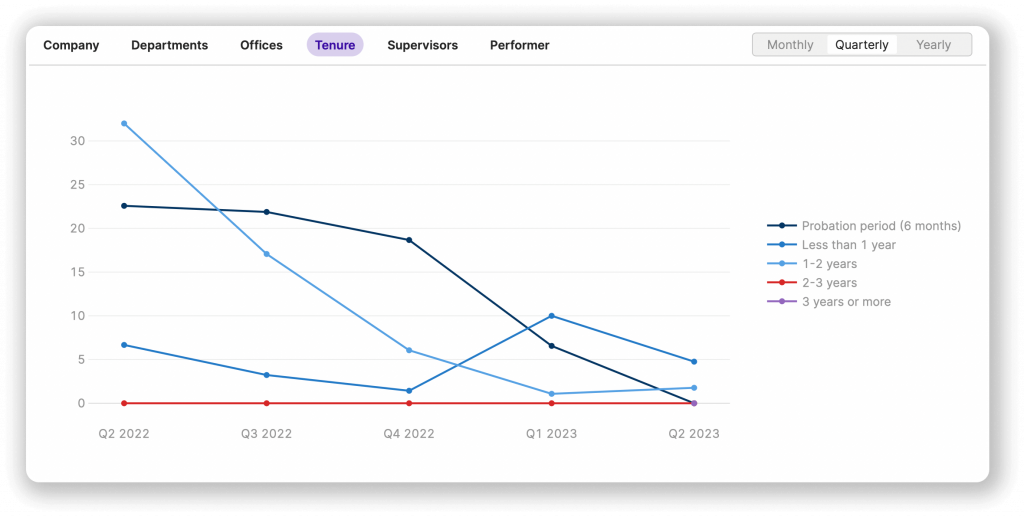People Analytics: New directions for HR in recession times
09 Feb

What is People Analytics?
People analytics is a strategic human resource management tool that enables data from multiple sources to be used using information and analytics methods to optimize the impact of human resource interventions and organizational business performance. It involves the use of technology to provide descriptive, visual and statistical analysis of data on people processes, human capital, business performance and external benchmarks. People analytics can help improve the HR system and other adjacent areas and achieve sustainable business success. People analytics comprises three stages of development that can be distinguished in terms of the objective, the analytic techniques used, and their strategic benefits. It is also known as HR Analytics, Talent Analytics, Workforce Analytics, Workforce Intelligence, HR Data Science or People Science. In our article What is People Analytics? An Essential Guide to Get Started we share more important information to get started with People Analytics.
Why is People Analytics important for companies?
People analytics is a powerful decision-making tool that penetrates the board level and is an important tool for strategic business management. It can help companies anticipate and actively incorporate change to prepare them for the future and digitally position them. People analytics manages HR professionals to identify fluctuations and trends and can help leaders take a strategic approach.
Training, retirements, restructuring, and recruiting new employees can all be aligned with the needs of the business and the desires of employees with the information. In addition, people analytics can help optimize costs within the company and achieve specific goals, such as high customer satisfaction.
In addition, people analytics can also help improve the data-driven decision-making quality in human resource management and help companies to be strategic, efficient and effective. Thus, it helps companies achieve a higher return on investment in the long run.
In our article Leveraging Data to Optimize Your Workforce we show some examples of why people analytics is so important.
Benefits of people analytics for human resource management
Understanding people based on data
Data analytics can help organizations better connect data systems, enabling better analysis of connected data sets. This can help organizations develop a deeper understanding of critical aspects of workforce management, including competition for qualified employees, decreases in employee retention, economic fluctuations, and adoption of new technologies and media. This information can then help them make better decisions by making predictions based on the qualitative and quantitative drivers. In this way, companies can increase economic efficiency by investing more in their employees’ work environment and ensuring that their employees are satisfied with working conditions. Analyzing data can help make HR management more effective and productive in the longer term.
Simplified personnel selection and screening processes
People analytics can create a new dimension of organisation selection and talent development. By integrating data into personnel selection processes, companies can improve the quality of personnel selection while saving time and money. The use of people analytics enables companies to gain insights into the potential performance and hiring characteristics of candidates to make informed personnel selection decisions. Because of efficient staff selection, companies can also save time by avoiding unnecessary recruiting and hiring. By automating screening processes, companies can also make initial contact with qualified candidates, which increases the quality of the recruitment process. Another benefit is that by collecting data related to job skills and employee success, companies can more accurately measure the effectiveness of their talent acquisition efforts. By using people analytics, companies can thus make their personnel selection processes more efficient and thus reap the benefits of people analytics for HR management.
Higher efficiency of personnel selection
People analytics helps in personnel selection by improving the empirical foundation of HR decisions, thereby reducing the likelihood of costly wrong decisions. By determining job qualifications and measuring potential candidate preferences, analytics can help pre-screen and select candidates for an open position. This saves time by replacing manual processes, improves the quality of recruitment by avoiding unconscious bias, and collects data that can be correlated with business results. This enables recruiters to make talent acquisition a strategic function by providing actionable business insights.
Improved quality of work and workforce performance
People Analytics helps organizations improve the quality of work and performance of their workforce. By analyzing the needs of employees, their satisfaction and engagement are strengthened. Because of this, they are less prone to turnover and feel motivated to do their best. In addition, multiple people can have a more comprehensive view of potential developments than individuals. With the help of people analytics, HR departments can measure and evaluate employee performance to develop plans and actions to improve underperforming areas. With a productivity index, companies can also calculate the impact of each employee on overall success to determine the economic value of their workforce. When companies rely on people analytics, they can measure, evaluate, and target improvements to the quality of work and performance of their workforce.
Improved Diversity and Culture
People analytics can help organizations gain a better understanding of the status quo of their diversity and improve the quality of the employee experience. This data helps organizations identify and effectively manage unintentional and intentional bias.
Based on people analytics, companies can get a comprehensive picture of their diversity and inclusion initiatives. One example is a technology company that had women in 24% of leadership positions (management and above) at the end of 2018, enabling it to achieve its goal of having at least 30% female leaders by 2022.
People analytics also offers benefits to employees by allowing them to track results and insights from investigations in real-time. This will help employees feel comfortable in an organization as their needs are recognized and taken seriously. This, in turn, can reduce workforce turnover as employees are more likely to envision themselves working at a company for the long haul.
Another benefit of people analytics is that it allows companies to leverage the different perspectives and experiences of multiple people to monitor predictable and unpredictable changes in real-time. This helps companies seize opportunities and increase their success. Finally, companies can benefit financially, as studies show that diverse teams are more creative and generate higher profits than homogeneous workforces.
Gain higher engagement and productivity rates
Workforce analytics can help HR increase engagement and productivity rates by capturing key workforce metrics to measure each employee’s performance. With the help of HR analytics, HR can better understand employee needs and make key decisions to increase their engagement and motivation. For example, HR costs per employee can be reduced by using resources more efficiently. Implementing innovative ideas and measuring employee engagement with people analytics can reduce employee turnover and productivity rates. Identifying the economic value of top performers and developing plans and actions to improve low-performing areas can also increase HR productivity. Creating a productivity index that takes into account cost-to-value ratios per employee and rewarding top-performing employees can help further increase productivity rates in the department.
Improved customer satisfaction and business results
By analyzing people relationships, companies can address employee needs, which in turn leads to higher employee satisfaction. In the process, innovative ideas are implemented and employee turnover is reduced. This increases employee productivity and creates new opportunities and models. This leads to higher customer satisfaction as business processes become faster and more efficient. This directly impacts the organization’s bottom line by reducing costs and increasing revenue in the long run. It also helps keep the business up to date, which increases competitiveness.
Improved resource planning and allocation
People Analytics helps organizations improve resource planning and allocation by analyzing workforce data to understand the current status of the workforce and make informed decisions about resource allocation. The framework prioritizes return on investment and therefore profit. With this approach, companies can save time and money by meeting their HR agenda, identifying skills gaps, and deciding whether to acquire, hire, or build. This allows companies to give their employees a fair assessment based on valid data. Our modern, data-driven approach gives them a competitive edge in the marketplace and can reduce their overall costs.
Improved workforce assessment and design
Analyzing employees using people analytics helps HR managers increase employee satisfaction and loyalty. This creates a stronger bond with the company, which ultimately leads to reduced turnover, cost savings, and increased productivity.
By soliciting employees’ opinions at regular intervals through feedback sessions, HR managers can understand what employees want and need to feel more fulfilled and comfortable at the company.
In addition, people analytics can also help managers to design and connect the work processes in the company. This ensures that the company stays on top of its game and that productivity increases.
HR Analytics enables leaders to measure the economic value of individual employees and target those values for improvement. This helps the company plan for the long term, cut costs, and implement innovative ideas.
Increased ability to target talent search
Talent analytics can help a company improve the capabilities of its HR managers by identifying management strengths and weaknesses, as well as gathering information on the span of control, compensation variations, and talent. Using this data, company leaders can make organizational processes more effective by promoting new leaders, reorganizing structures or consolidating operations. In addition, when companies use data to assess applicants’ personalities, not just real-world experience, they can reduce employee turnover. And by developing recruiting models, companies can correlate labour market data, salary data, and skills information to develop local recruiting strategies worldwide. These techniques can support HR managers by helping them make the best possible hiring decisions.
How people analytics can help in times of recession
Better understand how to find top talent and optimize your recruiting budget
People analytics can help companies acquire talent while optimizing their recruiting budgets. By analyzing and optimizing their compensation systems, companies can achieve pay that is recognized as fair and thus build profound employer branding. As a result, their jobs appear interesting and attractive, and there is less reliance on expensive headhunters and recruiters. People analytics can also help collect, store and analyze recruitment data. Linking this data to business data enables talent acquisition to become a strategic function. This can help companies gain a competitive advantage by responding more quickly and accurately to proposed offers and counter-offers. This advantage can also help employees who are considering a change stay with the company. In addition, companies can also save time and money by replacing manual processes in recruiting.
How to retain your top talent
People analytics can help overcome the recession by allowing companies to operate more efficiently. Companies can identify and empower the right talent to drive business performance and growth opportunities. With the help of people analytics, companies can identify the talent that exists within their organization and deploy it more efficiently, driving more results.
For companies facing resource shortages, People Analytics can be an important tool for reducing costs by simplifying the talent search and selection processes. By using Big Data, companies can analyze an applicant’s personality typology and better assess whether they are right for the job. Companies can then select and hire those individuals who are likely to stay with the company longer, rather than just looking at their work experience.
In addition, with people analytics, companies can globalize their recruiting strategies to gain access to a widespread employee base and select candidates based on local labour markets and needs. By using people analytics tools, companies can also increase the effectiveness of their recruiting initiatives by achieving better results in less time.
People analytics can help companies lower their employee turnover rates by enabling them to better empower employees and understand how to best utilize their talent. It can help companies reduce costs by hiring more efficiently and hiring fewer employees with low intent over the long term.
Identify trends early on that have an impact on morale and productivity
People analytics can identify trends that have an impact on morale and productivity, allowing leaders to identify flawed operations early and innovate to stay current in the competitive landscape. People analytics also enables organizations to determine the economic value of top performers and determine the cost-to-value ratio per employee. By providing response measures, companies can improve underperforming areas to increase productivity per employee. In this way, companies can achieve more profit per employee.
Finding new ways to develop talent and foster innovation
In times of recession, it is important to find new ways of developing talent and fostering innovation to overcome the economic downturn and enable successful growth. People Analytics offers an innovative solution. With the modern tools of data analytics, companies can identify current trends and make informed decisions. To increase workforce effectiveness, companies can analyze existing demographic data, skills, engagement information and performance ratings.
Another approach is to recognize that promoting diversity is not just about diversity, but more importantly about equality, equity and opportunity. It is important that companies adapt the world to reality and not the other way around. Algorithms can help program this process without prejudice. This shows the importance of using the right tools for the right tasks.
Overall, people analytics is a revolutionary way to increase the efficiency of talent development and foster innovation and lead the economy out of recession. Organizations must use the right data analytics tools to get the best possible results.
Identify weaknesses in your organization and find ways to improve them
People analytics can help identify and improve weaknesses in the organization by helping companies ask the right questions, select data from various systems, and clean and analyze the data. First, organizations should start with simple questions, such as “Which employees are my high potential?” This question can already be answered using simple statistics. Then, the data must be selected, combined and analyzed. This gives companies the basis for modern, strategic HR management and prioritization of return on investment and overall profit.
Once you ask the right questions about things you can change, such as leadership style or engagement, you can gain better insights and then translate them into performance improvements and action items. For example, with people analytics, companies can find out which employees are most likely to leave the company. This information can benefit strategic workforce planning.
In addition, people analytics can help quantify the relationships between people skills and organizational outcomes, track absenteeism, capture turnover, uncover suspected burnout, and measure performance. This information can then be used to create a better work environment, identify future leaders and boost employee motivation. All of this leads to greater efficiency, more profits and lower employee turnover.
Improve the efficiency of compensation models
Compensation model analysis can increase the efficiency of people analytics by collecting and analyzing more data. Employee compensation profiles, incentive scores, performance ratings, and comparables collected through People Analytics form the basis for strategic human resource management. This data can be used to determine which employees are a flight risk, proactively initiate retention efforts to reward top performers, or identify underperforming employees and take appropriate action to improve their performance. This data also helps measure employee engagement and determine the extent to which existing engagement programs are effective. Overall, compensation model analysis can help people analytics become more effective by optimizing companies’ return and value on investment.
The recession is challenging for companies, but there are ways to adapt and move on. This guide offers valuable tips for companies looking to deploy and improve people analytics. Join our waiting list now and get early access to our People Analytics platform!
Get started
peopleIX connects all your HRIS, ATS and other HR data sources to create a unified view of your workforce. Get a personalized demo around your unique pain points and discuss your company’s specific needs. Find out how peopleIX can help you on your people analytics journey. Or discover our use cases in the areas of people, recruiting, retention and DEI.
Related Post
Recent Posts

People Analytics: Definition, Goals & Implementation
October 8, 2024
The evolving role of HR: From People Manager to Strategic Leader
August 27, 2024Categories
- Analytics (2)
- Collaboration (1)
- Customer Sucess Stories (1)
- Data Management (1)
- Foundations (9)
- Human Resources (HR) (3)
- Platform (1)
- Recession Times (2)
- Tech Stack (1)
- Uncategorized (4)
- Use Cases (4)
PRODUCT
People Planning & Scenarios
Sharing & Collaboration
RESOURCES
LEVEL UP
STAY IN THE LOOP
Copyright © 2024 peopleIX GmbH. All rights reserved.

